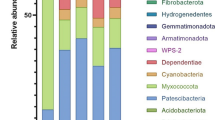Abstract
The genus Acanthamoeba includes pathogenic strains which are causative agents of keratitis and encephalitis that often may end fatal in humans and other animals. In the present study, forty soil samples were collected in the island of El Hierro, Canary Islands, Spain, and checked for the presence of Acanthamoeba. Samples were cultivated onto 2 % non-nutrient agar plates seeded with a layer of heat killed Escherichia coli. Amplification by PCR and sequencing of the DF3 region of the 18S rDNA of Acanthamoeba was carried out in order to confirm morphological identification of the amoebae. Furthermore, Acanthamoeba spp. was isolated from 47.5 % of soil samples. Moreover, genotypes T2, T4, and T11 were identified in these samples. To the best of our knowledge, this is the first study to establish genotypes T2, T4, and T11 in soil sources from El Hierro island.


Similar content being viewed by others
References
Booton GC, Visvesvara GS, Byers TJ, Kelly DJ, Fuerst PA (2005) Identification and distribution of Acanthamoeba species genotypes associated with nonkeratitis infections. J Clin Microbiol 43:1689–1693
Corsaro D, Walochnik J, Köhsler M, Rott MB (2015) Acanthamoeba misidentification and multiple labels: redefining genotypes T16, T19, and T20 and proposal for Acanthamoeba micheli sp. nov. (genotype T19). Parasitol Res 114(7):2481–2490
Geisen S, Fiore-Donno AM, Walochnik J, Bonkowski M (2014) Acanthamoeba everywhere: high diversity of Acanthamoeba in soils. Parasitol Res 113(9):3151–3158
Lorenzo-Morales J, Ortega-Rivas A, Foronda P, Martínez E, Valladares B (2005) Isolation and identification of pathogenic Acanthamoeba strains in Tenerife, Canary Islands, Spain from water sources. Parasitol Res 95(4):273–277
Lorenzo-Morales J, López-Darias M, Martínez-Carretero E, Valladares B (2007) Isolation of potentially pathogenic strains of Acanthamoeba in wild squirrels from the Canary Islands and Morocco. Exp Parasitol 117(1):74–79
Lorenzo-Morales J, Martín-Navarro CM, López-Arencibia A, Arnalich-Montiel F, Piñero JE, Valladares B (2013) Acanthamoeba keratitis: an emerging disease gathering importance worldwide? Trends Parasitol 29(4):181–187
Lorenzo-Morales J, Khan NA, Walochnik J (2015) An update on Acanthamoeba keratitis: diagnosis, pathogenesis and treatment. Parasite 22:10
Maciver SK, Asif M, Simmen MW, Lorenzo-Morales J (2013) A systematic analysis of Acanthamoeba genotype frequency correlated with source and pathogenicity: T4 is confirmed as a pathogen-rich genotype. Eur J Protistol 49(2):217–221
Magnet A, Henriques-Gil N, Galván-Diaz AL, Izquierdo F, Fenoy S, del Aguila C (2014) Novel Acanthamoeba 18S rRNA gene sequence type from an environmental isolate. Parasitol Res 113:2845–2850
Nuprasert W, Putaporntip C, Pariyakanok L, Jongwutiwes S (2010) Identification of a novel T17 genotype of Acanthamoeba from environmental isolates and T10 genotype causing keratitis in Thailand. J Clin Microbiol 48:4636–4640
Qvarnstrom Y, Nerad TA, Visvesvara GS (2013) Characterization of a new pathogenic Acanthamoeba species, A. byersi n. sp., isolated from a human with fatal amoebic encephalitis. J Eukaryot Microbiol 60:626–633
Rahdar M, Niyyati M, Salehi M, Feghhi M, Makvandi M, Pourmehdi M, Farnia S (2012) Isolation and genotyping of acanthamoeba strains from environmental sources in Ahvaz City, Khuzestan Province, Southern Iran. Iran J Parasitol 7(4):22–26
Reyes-Batlle M, Todd CD, Martín-Navarro CM, López-Arencibia A, Cabello-Vilchez AM, González AC, Córdoba-Linús E, Lindo JF, Valladares B, Piñero JE, Lorenzo-Morales J (2014) Isolation and characterization of Acanthamoeba strains from soil samples in Gran Canaria, Canary Islands. Spain Parasitol Res 113(4):1383–1388
Siddiqui R, Khan NA (2012) Biology and pathogenesis of Acanthamoeba. Parasit Vectors 5:6
Tamura K, Peterson D, Peterson N, Stecher G, Nei M, Kumar S (2011) MEGA5: molecular evolutionary genetics analysis using maximum likelihood, evolutionary distance, and maximum parsimony methods. Mol Biol Evol 28:2731–2739
Todd CD, Reyes-Batlle M, Martín-Navarro CM, Dorta-Gorrín A, López-Arencibia A, Martínez-Carretero E, Piñero JE, Valladares B, Lindo JF, Lorenzo-Morales J (2015) Isolation and genotyping of Acanthamoeba strains from soil sources from Jamaica, West Indies. J Eukaryot Microbiol 62(3):416–421
Valladares M, Reyes-Batlle M, Martín-Navarro CM, López-Arencibia A, Dorta-Gorrín A, Wagner C, Martínez-Carretero E, Piñero JE, Valladares B, Lorenzo-Morales J (2015) Molecular characterization of Acanthamoeba strains isolated from domestic dogs in Tenerife, Canary Islands, Spain. Arch Microbiol 197(5):639–643
Acknowledgments
This work was supported by the grants RICET (project no. RD12/0018/0012 of the program of Redes Temáticas de Investigación Cooperativa, FIS), Spanish Ministry of Health, Madrid, Spain; the Project PI13/00490 “Protozoosis Emergentes por Amebas de Vida Libre: Aislamiento, Caracterización, Nuevas Aproximaciones Terapéuticas y Traslación Clínica de los Resultados” from the Instituto de Salud Carlos III; and Project ref. AGUA3 “Amebas de Vida Libre como Marcadores de Calidad del Agua” from CajaCanarias Fundación. ALA and MRB were funded by Becas de Investigación Obra Social La Caixa-Fundación Cajacanarias para Postgraduados 2014. IS was funded by Ayudas para estancias investigadores—ULL, 2015. JLM was supported by the Ramón y Cajal Subprogramme from the Spanish Ministry of Economy and Competitivity RYC-2011-08863. Authors are grateful to Jorge Rodríguez for his help during the sampling in the island of El Hierro.
Author information
Authors and Affiliations
Corresponding author
Rights and permissions
About this article
Cite this article
Reyes-Batlle, M., Zamora-Herrera, J., Vargas-Mesa, A. et al. Acanthamoeba genotypes T2, T4, and T11 in soil sources from El Hierro island, Canary Islands, Spain. Parasitol Res 115, 2953–2956 (2016). https://doi.org/10.1007/s00436-016-5048-8
Received:
Accepted:
Published:
Issue Date:
DOI: https://doi.org/10.1007/s00436-016-5048-8




